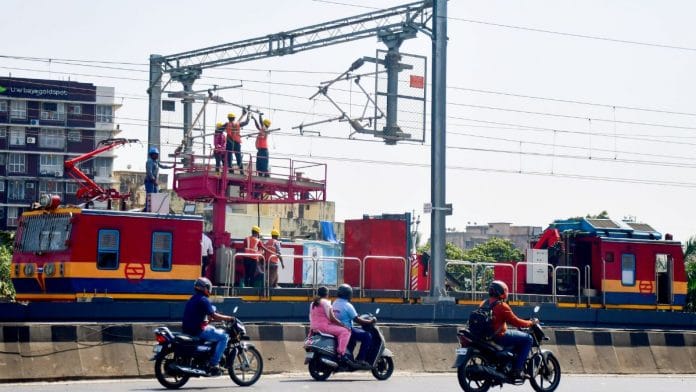Mumbai: After overcoming major hurdles and a delay of two years, the longest underground Metro line in Mumbai — and one of the city’s costliest transport infrastructure projects — will finally be ready for commissioning in December 2023.
The Mumbai Metro Rail Corporation (MMRC) Wednesday completed 100 per cent of the tunnelling work, a daunting task in itself. Around the same time, the Supreme Court cleared the deck for the metro car shed to be constructed at Aarey, which has been a hot political controversy in the state for over half a decade.
“As of now, the overall project is 77 per cent completed. We recently got the clearance for the depot and now the first phase will be commissioned by December 2023 and second phase will be functional after a lag of six months, i.e in June 2024,” said S.K. Gupta, Project Director, MMRC.
The Metro-3 line is 33.5-km-long and will run between Colaba-Bandra-Seepz. It is also the first underground corridor of the metro network coming up in the city. Of the 27 stations on this line, 26 will be underground. It is considered to be key as it proposes to connect the tip of south Mumbai to the city’s north, linking business districts, including the Bandra-Kurla Complex (BKC). The Metro line will also provide connectivity to the Chhatrapati Shivaji Maharaj International Airport.
The line will also be convenient for commuters as it will provide connectivity, at eight different spots, with the railways, the Maharashtra State Road Transport Corporation (MSRTC) and other under construction metro lines.
MMRC’s next big challenge would be putting in place a completely integrated system, along with supply line transport, said Gupta.
The integration of systems is a daunting task because of the nature of the metro. Since it is underground, the geology of the city — made of marine clay and hard basalt rock — is also a factor. Plus, in a particular stretch, the Mumbai Metro passes under the Mithi river.
The trains running underground will have to coordinate with the signaling systems and all technologies must communicate with every other part, which will be a challenge, said Gupta.
Also read: Among Shinde’s 1st moves as CM — scrapping Aarey Metro shed relocation he backed as Uddhav mantri
The underground metro
The tunnelling work for Metro-3 began in 2017 when the first tunnel boring machine (TBM) arrived in the city. Since then, it has taken the MMRC five years to complete the entire tunnelling. The Covid pandemic also hampered the progress, but mostly, the line ran into controversies leading to delays.
The controversial car shed and its location in Aarey has led to a political tussle in Maharashtra between the Shiv Sena (Uddhav Balasaheb Thackeray) and the Bharatiya Janata Party (BJP).
The Aarey Metro car depot also faced stiff resistance from environmentalists and activists who staged multiple protests at the site with a large number of people from the civil society joining them.
But the matter got some direction when the Supreme Court Tuesday decided to allow MMRC to pursue its application before the Tree Authority for felling 84 more trees to construct a ramp for the project. The agency has already cut over 2,000 trees in Aarey forest for the depot.
Now, the agency can go ahead with its construction inside Aarey, which it said is crucial for commissioning the line.
“We have to complete a lot of work on the depot. We have a crunched timeline. So before commissioning the first line, a depot needs to be in place,” said Gupta.
Now, the next task before the MMRC is to complete its civil work and systems work. The civil work, which includes building the stations, is 88 per cent completed. Meanwhile, the systems work, which includes rolling stocks, platform screen doors, signals, escalators and tracks, is 43 per cent done.
But all work is happening simultaneously and at the same speed, said Gupta. Many of the areas are congested, especially Kalbadevi and Girgaon, where stations would be constructed very near buildings and some areas are important from a heritage point of view, he added. He also talked about how the different geologies, traffic requirements, space requirements and different surroundings make station construction challenging.
“All these factors have to be integrated. There is a lot of commonality but also many differences,” said Gupta.
Why the Metro-3 line is important
As per MMRC’s traffic predictions, the maximum traffic would be between BKC — also a point of connection to different Metro lines — and Cuffe Parade. So, the frequency of trains in this belt would be higher. MMRC expects 14 million people to use the line every day, but this could change, said Gupta. The total cost the MMRC is looking at, with a revised estimate, is Rs 37,276 crore
The tunnelling work was very crucial for the progress of this line, said Gupta.
For example, in South Mumbai’s Kalbadevi, Girgaum and Grant Road areas, the geology was difficult and the structures above were also old and precarious. The density of the area is also high, making construction work difficult, said Gupta. Acquiring the portion of land for stations and convincing the people in the area also took a lot of work, he added.
Around the BKC area, the station is close to a water body and some components are going below the water body, so all stations have different characteristics, he said.
Gupta also spoke of the importance of the car shed. According to him, a depot was needed to start a line and without it, the commissioning of the line would be difficult as the depot has a control system for the line.
But with these two tasks accomplished, the commissioning of the line would take place by December next year, Gupta said.
(Edited by Zinnia Ray Chaudhuri)
Also read: Under creaky buildings & rail lines, near the sea — how Mumbai underground Metro is taking shape






